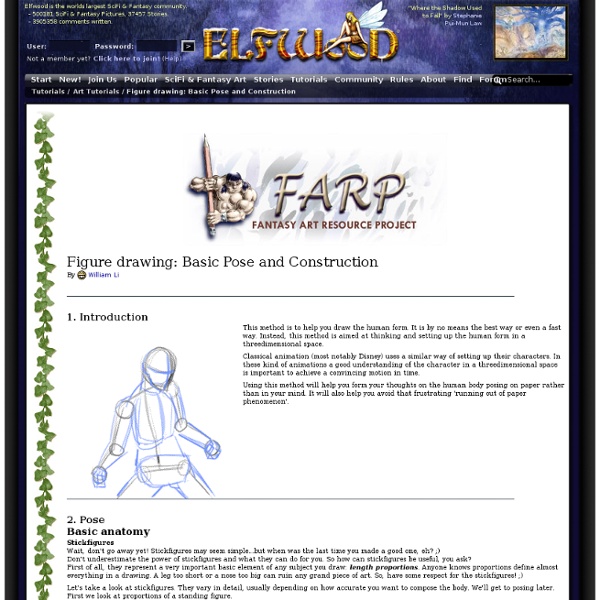'All the Wrong Reasons'
Everyone makes experimental films when they dream. Dreams are picture-driven, non-linear quilts of movie-like moments sprinkled with cryptic epiphanies. They play nightly in the private cinema of your head but the rub is the audience must be asleep. Then again, maybe sleep, or at least the suspension of conscious thought, is the ideal state for entering such a movie. “All the Wrong Reasons” is an experiment in making a film that feels as if it has percolated up from the subconscious; a dream you can watch with your eyes open. There are almost 3,000 paintings and collages in this film.
hetler
How to Draw a Face (with pictures)
Steps Method 1 of 3: A Female Face, Sketched 1Make a light outline of a face. Heads are never circular, they are oval shaped, like an egg. 12Clean. Method 2 of 3: Male 1Drawing lightly, sketch a circle. 2Draw a line at the middle starting from the top and ending where the chin would be. 11Optional: add shading to the drawing if needed. Method 3 of 3: Female Face 1Draw the shape of the head you have in mind. 2Add lines to determine the center of the face and the position of the eyes. 3Sketch lines to define how wide, tall, and the placement of the eyes, nose, mouth and ears. 4Sketch the shape and appearance of the eyes, nose, mouth, ears, and eyebrows. 5Sketch the shape of the hair and neck. 6Use a smaller tipped drawing tool to add the finer details of the face. 7Draw the outline using the sketch as a guide. 8Erase and remove the sketch marks to produce a clean outlined drawing. 9Add color and shading to the drawing. Tips Practice makes perfect.Don't give up. Ad Article Info
Drawing Hands
This short tutorial is a just a small taste of a larger and much more in-depth book I wrote called The Mad Art of Caricature! The book is 175 full-color pages, lavishly illustrated and contains greatly expanded explanations of the concepts presented in this tutorials, as well and a great deal of additional material on caricaturing other facial features, posture, hands, expression and more, techniques on drawing from live models, doing caricature for freelance illustration and for MAD Magazine. This is a must have book for anyone interested in caricature, cartooning or humorous illustration. You can order it online here. How to Draw Hands Easily the most asked question I get is “how do you draw caricatures?”. Next to faces, hands are probably the most expressive and intricate part of the human form. I’m a cartoonist at heart, so the hands I draw are not realistic hands by most definitions. Breaking Down Hand Structure Not really much to it, is there? Relationships of Hand Structure
Download Over 250 Free Art Books From the Getty Museum
Yesterday, we wrote about the Wellcome Library’s opening up of its digital archives and making over 100,000 medical images freely available online. If you’ve already made your way through this choice selection (or if the prospect of viewing a 19th century leg amputation doesn’t quite pique your curiosity) have no fear. Getty Publications just announced the launch of its Virtual Library, where readers can freely browse and download over 250 art books from the publisher’s backlist catalogue. The Virtual Library consists of texts associated with several Getty institutions. Readers can view extensively researched exhibition catalogues from the J. Paul Getty Museum, including Paul Cézanne’s late-life watercolours, when the painter raised the still life to a high art (Cézanne in the Studio: Still Life in Watercolors, 2004), as well as the woefully underappreciated Flemish illustrations of the 15th and 16th centuries (Illuminating the Renaissance: The Triumph of Flemish Manuscript, 2003).
Portrait drawing: a simple approach
Portrait drawing is one of those drawing skills many people get into drawing for. It is so appealing and rewarding being able to draw a portrait of a friend, a lover, a kid in a way that makes them happy and you proud of it. But drawing a portrait that captures the resemblance and the "soul" of a subject it is not an easy task and a skill that for many takes year to master and hone. For this reason I am not going to focus this tutorial on the "capturing the soul" part (at least not for now) and I will instead focus on "getting the proportions right" to at least capture the appearance of your subject (this alone will bring you a long way toward becoming a proficient portrait drawer). In this tutorial I'll examine a method to draw portraits that is suitable for drawing from a picture and from a real person posing for you. I do not want to overwhelm you with details and I'd rather prefer moving rapidly to the drawing, making comments and observations along the way. Lets' get started! Done? 1.
Lackadaisy Expressions
Boy, I didn't know what I was getting myself into when I started this. I've had requests for some sort of expressions tutorial dating back a while now, so I figured, "Sure! I can explain expression drawing...and it'll be way better than all those tutorials out there that are nothing but charts of generic expressions. Yeah! Um. Anyway, I found all I could really do was try to explain ways to teach yourself...and then add some pictures.



